Oscar Niemeyer shaped Brazilian modernism with his concrete constructions featuring bold geometric forms. In Brasília, the capital he helped design, the Cathedral stands out with its sixteen columns rising 40 meters (131 feet) high, while the National Congress combines two 28-story towers with opposing domes, one facing upwards for the House of Representatives, the other downwards for the Senate. The Niterói Contemporary Art Museum, with its circular shape resting on a central support, overlooks the bay of Rio de Janeiro. His work extends beyond Brazil. In Paris, the headquarters of the French Communist Party reflects his architectural vision, as does the Asturian Cultural Center in Spain. These international projects extend the architect’s influence beyond his homeland. In São Paulo, the Copan Building showcases its curved S-shaped facade stretching 115 meters (377 feet), containing 1,160 apartments across 32 floors. These works embody a modernist approach favoring concrete structures, geometric volumes, and natural light integration.
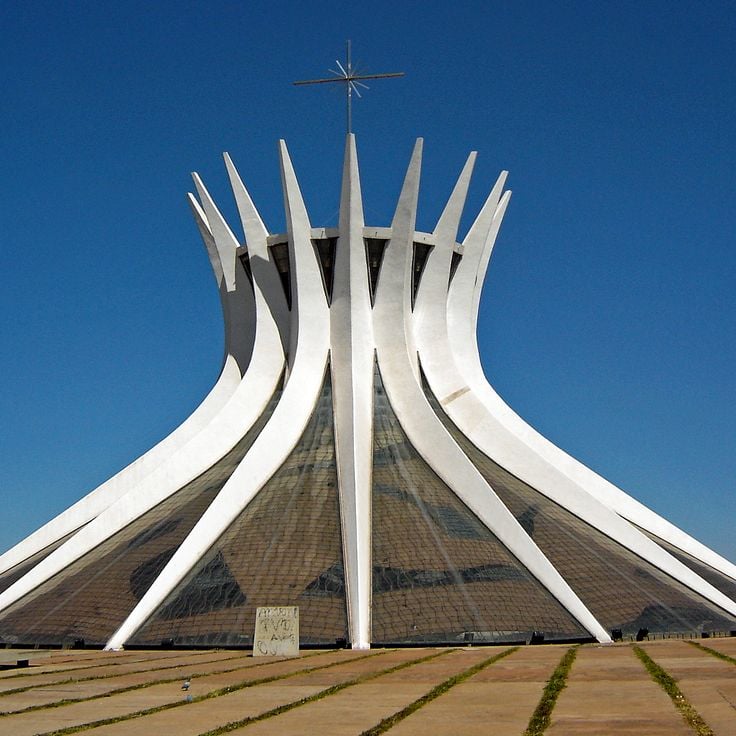
Federal District, Brazil
Cathedral of BrasíliaBrasília Cathedral showcases Oscar Niemeyer's characteristic use of concrete with sixteen vertical columns rising 131 feet (40 meters) high. Glass panels between the pillars fill the interior with natural light, illustrating the architect's geometric approach to Brazilian modernism. This church serves as an example of Niemeyer's structural innovation in his home country.

Federal District, Brazil
Congresso Nacional do BrasilThe National Congress of Brazil is an architectural work by Oscar Niemeyer, consisting of two administrative towers with 28 floors. Between these towers are a horizontal building and two domes. One dome houses the Chamber of Deputies and faces upward, while the other for the Senate faces downward. These geometric concrete forms embody the architect's modernist vision and define the urban landscape of Brasília. The building was completed in 1960 and belongs to the architectural ensemble of the Brazilian capital.
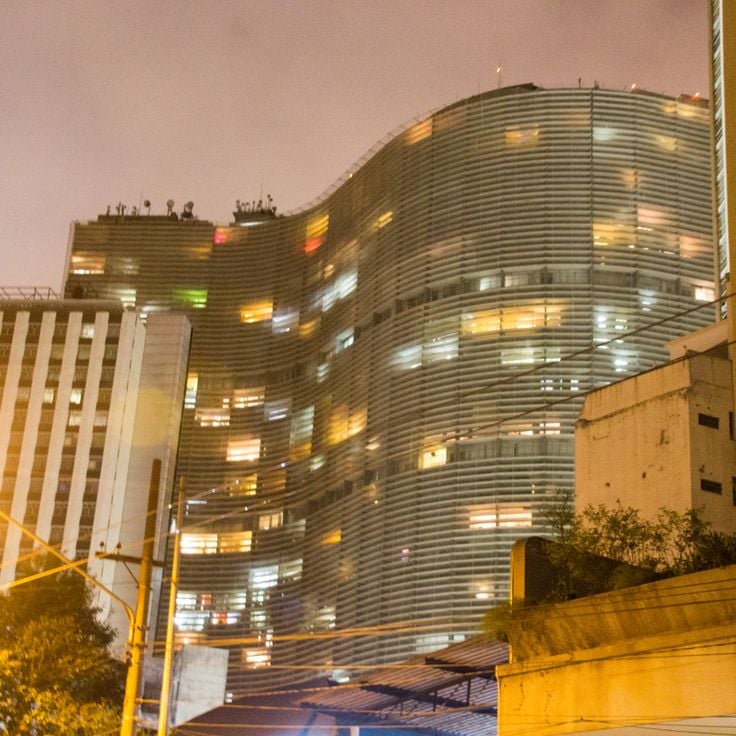
São Paulo, Brazil
Edifício CopanThe Edifício Copan is a residential building with 32 floors containing 1,160 apartments, rising approximately 460 feet (140 meters) in height. The distinctive S-shaped facade extends approximately 380 feet (115 meters) and demonstrates Niemeyer's use of curved lines in modernist residential architecture. The building represents his work with large-scale housing structures and organic forms in urban São Paulo architecture.
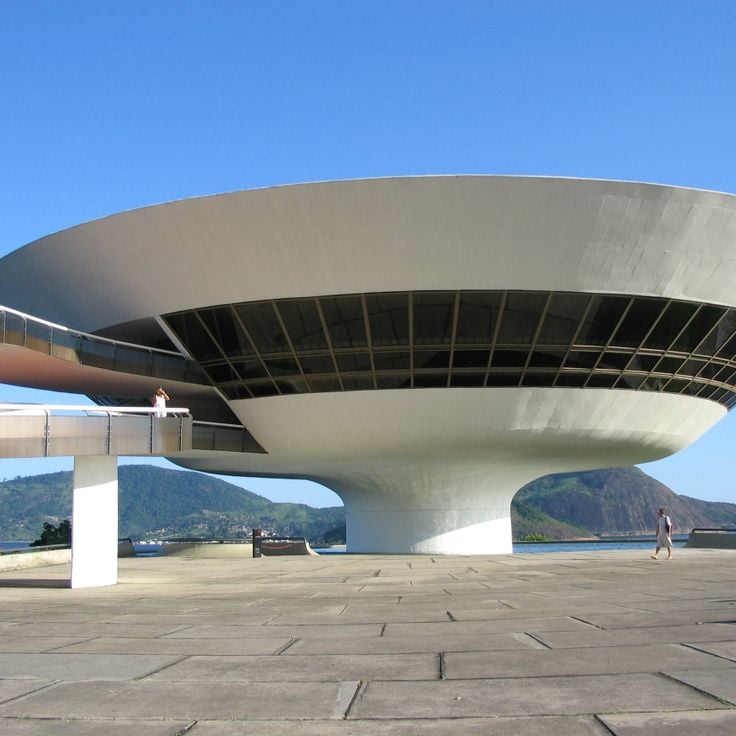
Niterói, Brazil
Museu de Arte Contemporânea de NiteróiThe Niterói Contemporary Art Museum is one of the landmarks of Brazilian modernism by Oscar Niemeyer. The circular building reaches 16 meters (52 feet) in height and rests on a central support pedestal. The gallery provides 2,500 square meters (27,000 square feet) of exhibition space overlooking Guanabara Bay. The curved concrete structure demonstrates Niemeyer's characteristic geometric forms.
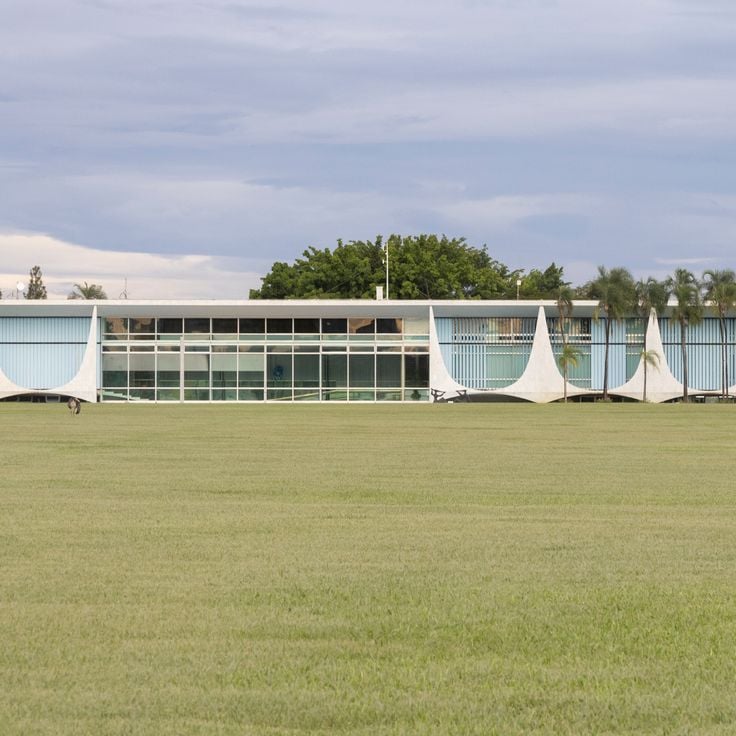
Brasília, Brazil
Palácio da AlvoradaThe Palace of the Dawn, built in 1958, serves as the official residence of the Brazilian president and embodies Niemeyer's vision of Brazilian modernism. The building rises on slender white marble columns that support a continuous glass facade, making the structure appear to float. These columns form a continuous portico surrounding the rectangular volume. The transparent facades enable a dialogue between the interior spaces and the surrounding landscape. The structure stands on the shore of Paranoá Lake and forms part of the architectural ensemble of the new capital alongside other government buildings.

São Paulo, Brazil
Parque Ibirapuera AuditoriumThis auditorium in Ibirapuera Park opened in 2005 and features an asymmetric form with a large red metal canopy at its entrance. The building complements Oscar Niemeyer's architectural vision for the park, which he shaped in the 1950s with several modernist structures. The concrete construction and distinctive colored canopy demonstrate Niemeyer's characteristic combination of geometric forms and expressive structural elements that define Brazilian modernism.
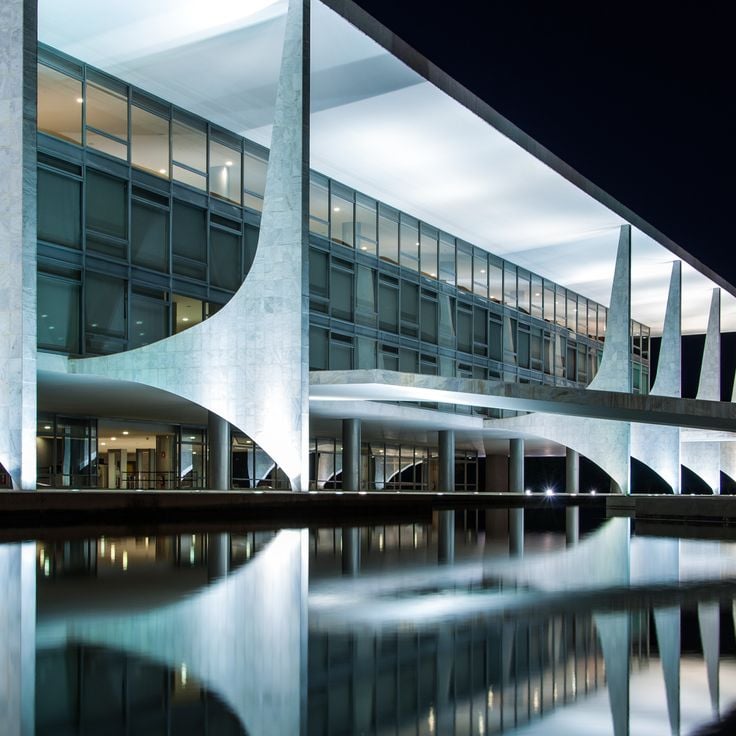
Brasília, Brazil
Palácio do PlanaltoThe Palácio do Planalto has served as the working space of the Brazilian president since its inauguration in 1960. The building displays characteristic columns and large glass panels on the main facade, illustrating Niemeyer's approach to integrating structure and transparency. As part of the architectural ensemble of Brasília, this palace demonstrates the use of concrete in bold geometric forms that became a hallmark of Brazilian modernism. The curved external columns support the building while creating an open, airy space inside.
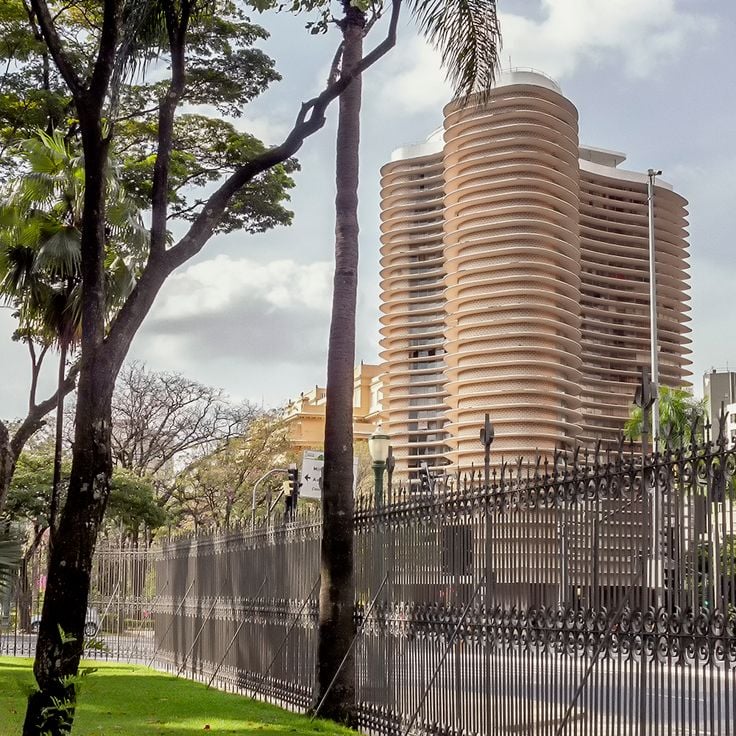
Belo Horizonte, Brazil
Niemeyer BuildingThis multi-story building with curved lines was constructed in 1955 and houses art exhibitions and cultural events. As part of Oscar Niemeyer's work in Brazil, the structure displays the characteristic geometric forms and concrete construction that shaped Brazilian modernism. The flowing curves of the building demonstrate Niemeyer's approach to combining organic forms with functional architecture, contributing to his international legacy that extends from Brasilia to Europe.
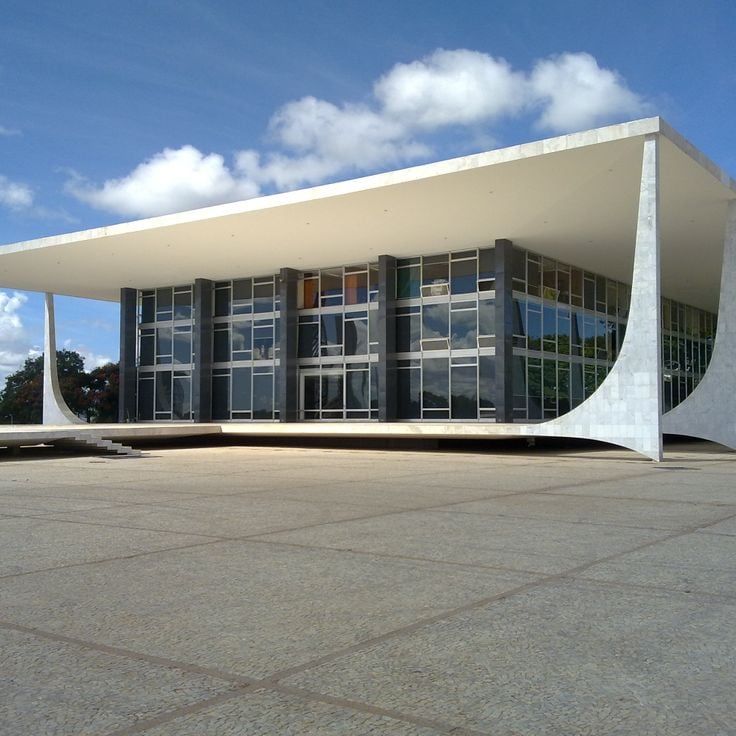
Brasilia, Brazil
Federal Supreme CourtThis modernist building of the Federal Supreme Court embodies Oscar Niemeyer's design principles through its slender concrete columns that support the main structure. The glass walls allow natural light into the interior and create a transparent connection between the judicial functions and Brasilia's urban environment. The building is part of the architectural ensemble of the Praça dos Três Poderes and represents Brazilian modernism with its geometric forms. The construction demonstrates Niemeyer's characteristic use of exposed concrete and his preference for clean, functional lines in public space.
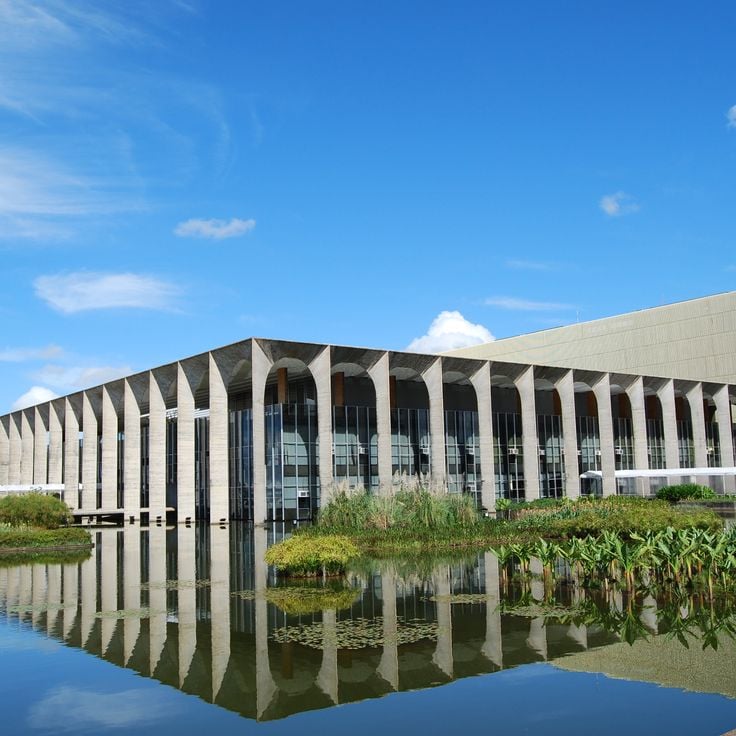
Brasilia, Brazil
Itamaraty PalaceThis palace in Brasilia serves as Brazil's Foreign Ministry and ranks among Niemeyer's major works. The concrete and glass structure features an entrance hall with a marble staircase surrounded by water pools. The architecture combines diplomatic functions with Niemeyer's characteristic modernist approach, emphasizing clear geometric lines and open spaces.
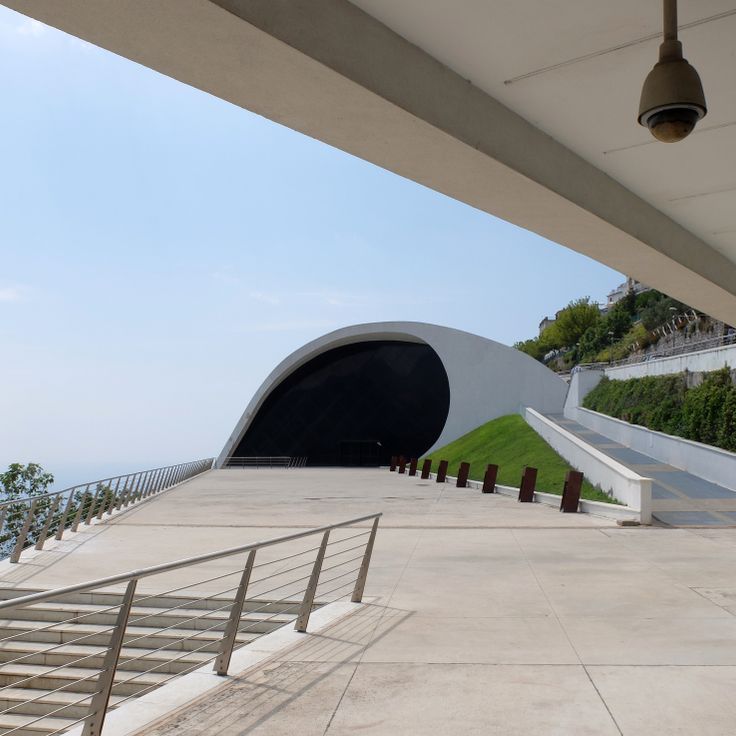
Ravello, Italy
Ravello AuditoriumBuilt into the coastal cliff, this concert hall combines modern concrete architecture with panoramic views of the Mediterranean Sea. The Ravello Auditorium was designed by Oscar Niemeyer and demonstrates his characteristic use of geometric forms in organic integration with the natural surroundings. The open structure frames the Amalfi Coast and creates a dialogue between architecture and landscape, embodying Niemeyer's modernist vision in a Mediterranean context.
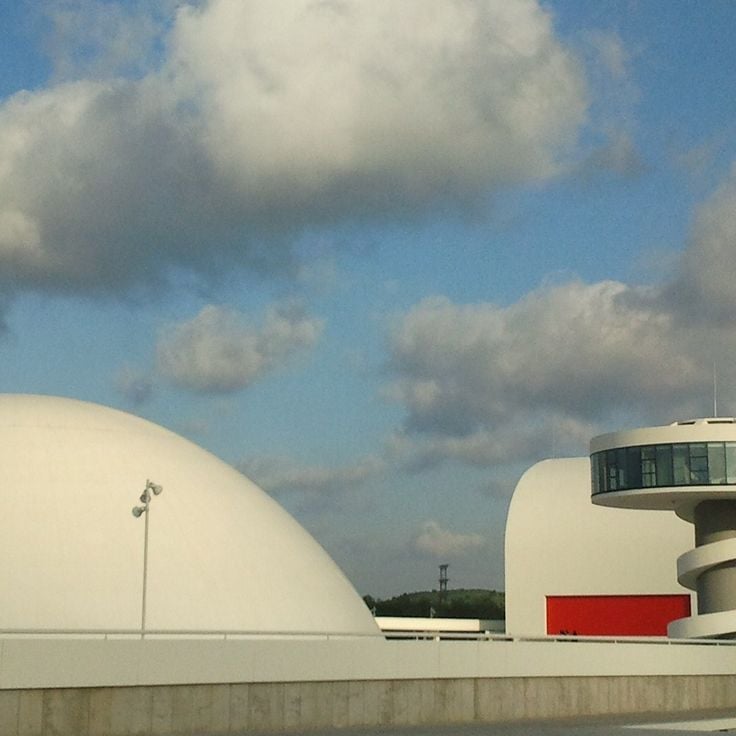
Avilés, Spain
Oscar Niemeyer International Cultural CentreThis cultural center in Avilés opened in 2011 and showcases Oscar Niemeyer's signature concrete architecture in a complex of white buildings along the estuary. The central dome structure combines exhibition spaces for contemporary art with a 1,000-seat auditorium and a tower building. The curved forms and bright white exterior demonstrate Niemeyer's geometric modernism in his European period. The center complements the architect's international body of work beyond Brazil and displays his principles of organic concrete construction in the Spanish coastal city.
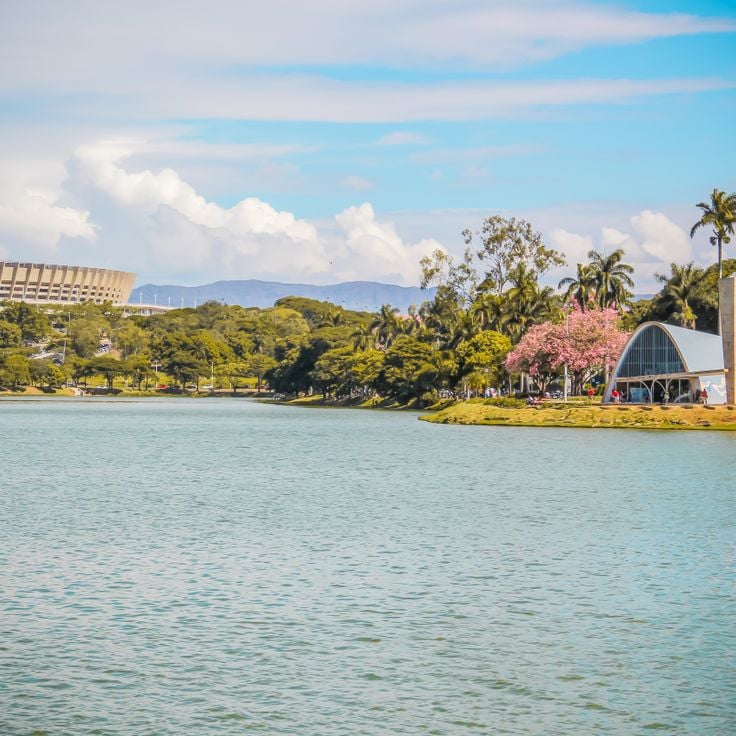
Belo Horizonte, Brazil
Pampulha Modern EnsembleThis architectural complex from the 1940s was designed by Oscar Niemeyer and brings together several buildings around a man-made lake. The ensemble includes the Igreja de São Francisco de Assis with its parabolic shell and azulejo tiles by Cândido Portinari, the Casino now serving as an art museum, the Casa do Baile with its curved terrace over the water, and the Iate Clube with its curved roof. These structures demonstrate Niemeyer's early experiments with organic forms and curved concrete construction that influenced his later work in Brasilia. The complex represents a turning point in modern Brazilian architecture.
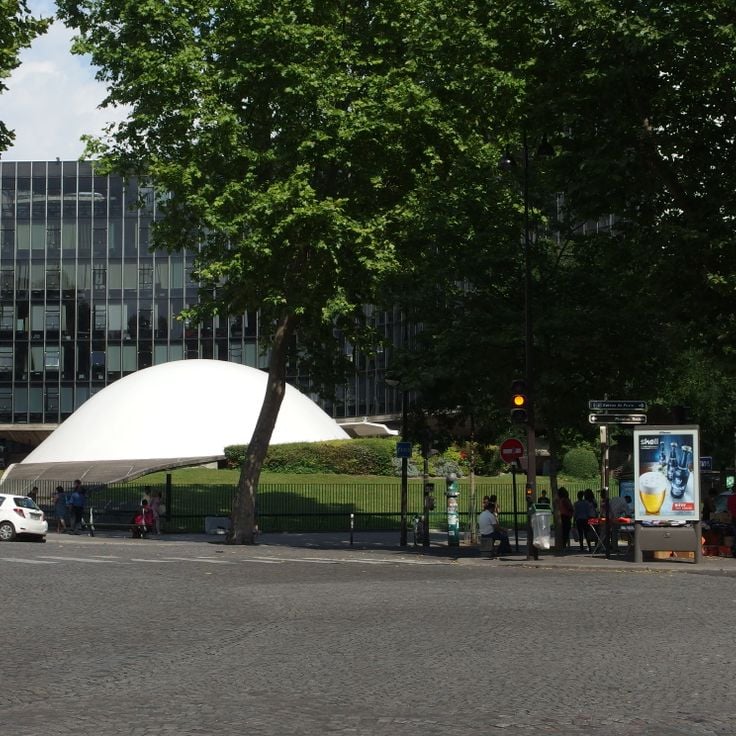
Paris, France
French Communist Party HeadquartersThe headquarters of the French Communist Party in Paris demonstrates Niemeyer's design principles through its white concrete facade and curved roof structure. Completed in 1971 under the commission of General Secretary Waldeck Rochet, the building occupies the Place du Colonel Fabien. This structure combines the organic forms characteristic of the Brazilian architect with the functional requirements of a political party headquarters, illustrating his capacity to create monumental public buildings beyond Brazil.
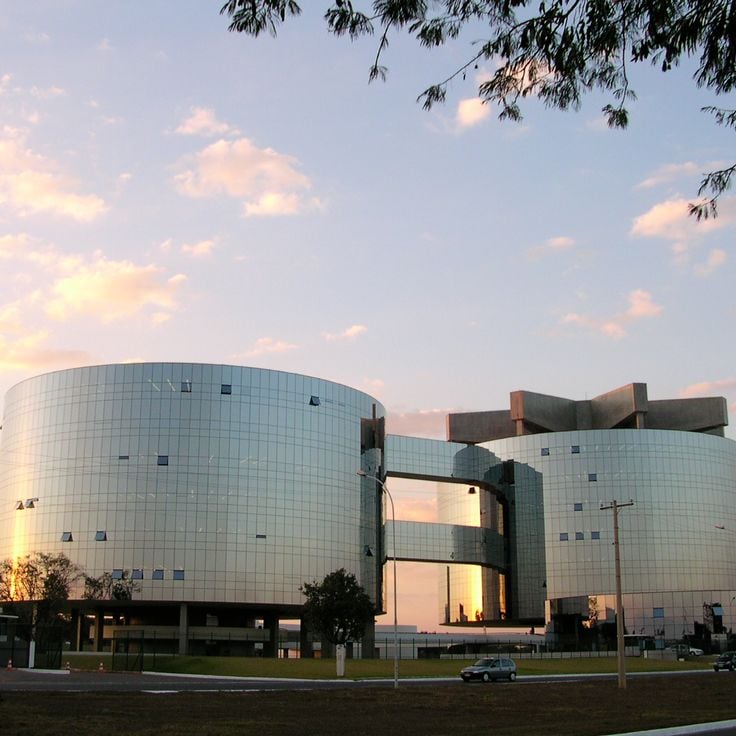
Brasília, Brazil
Federal Public Ministry HeadquartersThe headquarters of the Federal Public Ministry is an administrative building with geometric forms designed by Oscar Niemeyer and opened in 2002. The six-story structure embodies Niemeyer's characteristic use of concrete and clean lines that defined Brazilian modernism. As part of Brasília's architectural landscape, this headquarters fits into Niemeyer's overall vision for the capital and demonstrates his ability to design functional government buildings with expressive form.
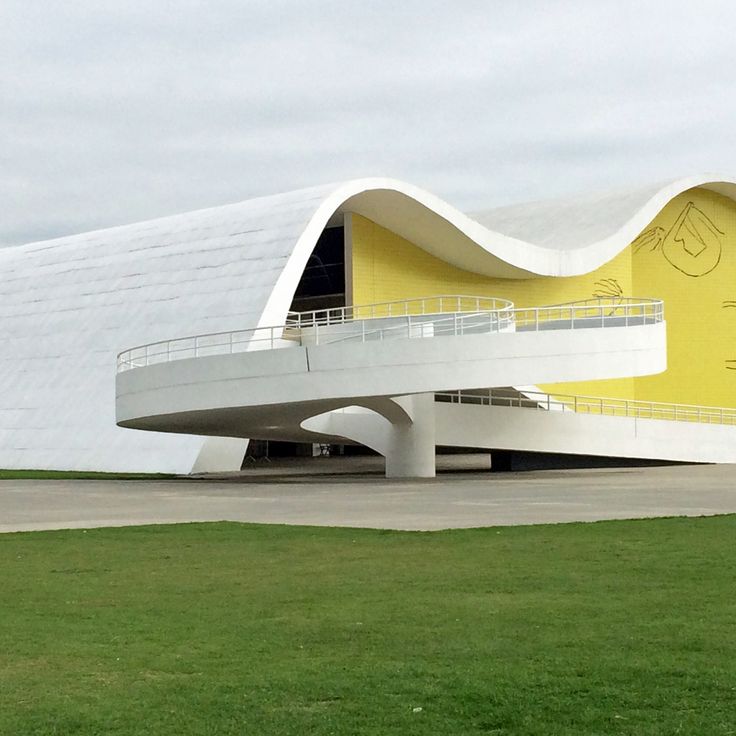
Niterói, Brazil
Popular Theatre of NiteróiThe Teatro Popular in Niterói is a 460-seat theater opened in 2007, part of Oscar Niemeyer's vision to advance cultural infrastructure in Brazil. This building is marked by its red exterior and distinctive structural concrete elements that reflect Niemeyer's design language. The theater was conceived to make performing arts accessible to a wide audience and complements Niemeyer's other works in Niterói, including the renowned Museu de Arte Contemporânea.
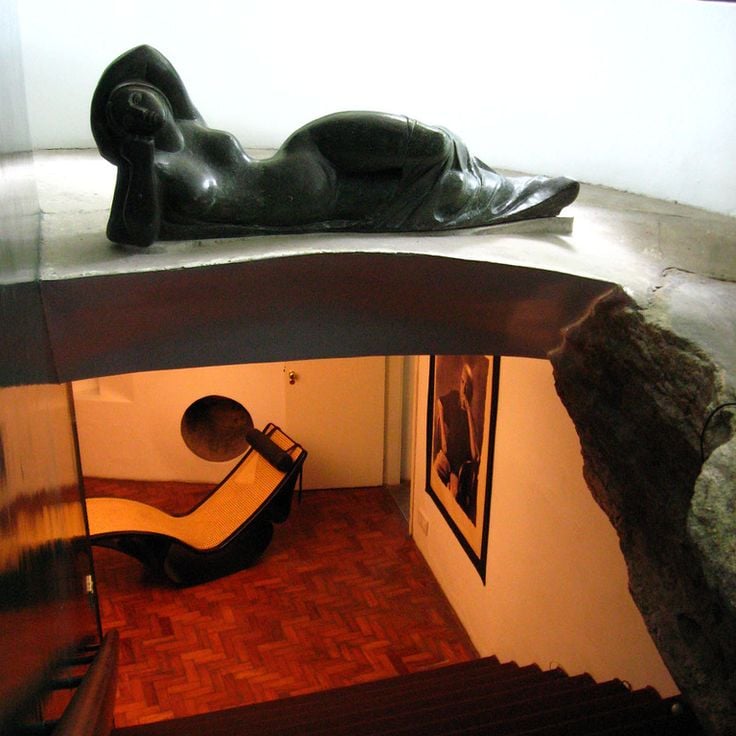
Rio de Janeiro, Brazil
Casa das CanoasThis private residence completed in 1953 combines concrete structures with large glass surfaces and incorporates a natural rock formation into the architecture. The Canoas House demonstrates Niemeyer's approach to connecting organic forms with the surrounding landscape. The curved lines and open design create a direct relationship between interior and exterior spaces. The rock integrated into the living areas serves as a central architectural element. The building showcases Niemeyer's characteristic use of concrete to create flowing, sculptural structures in dialogue with the natural environment.
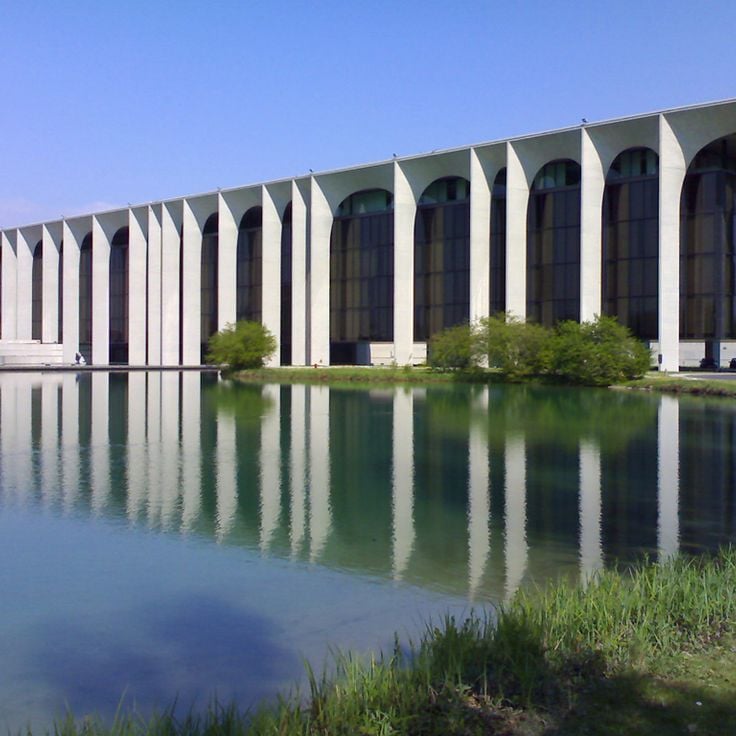
Lombardy, Italy
Mondadori Publishing Company's Office BuildingThe Mondadori publishing house building was completed in 1975 and consists of a series of concrete arches spanning five floors that surround an artificial lake. The structure demonstrates Niemeyer's characteristic use of curved forms and monumental arches that create a visual connection between architecture and landscape. The building serves as the headquarters of the Italian publishing company and showcases Niemeyer's ability to combine functional workspaces with sculptural elements.
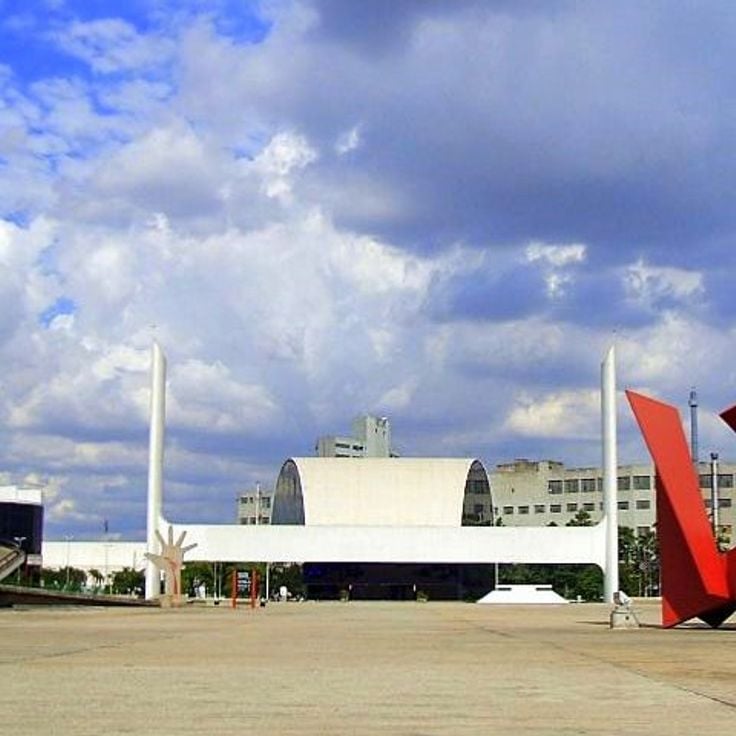
São Paulo, Brazil
Memorial da América LatinaThis cultural center opened in 1989 spans 909,000 square feet (84,500 square meters) and houses a library, exhibition spaces, and a conference hall. The Mémorial de l'Amérique Latine demonstrates Niemeyer's characteristic concrete structures with geometric forms and serves as a platform for Latin American culture and politics. The complex includes several buildings, notably the parliament building with its white curved facade and the hand sculpture symbolizing the bloodshed in Latin American history.
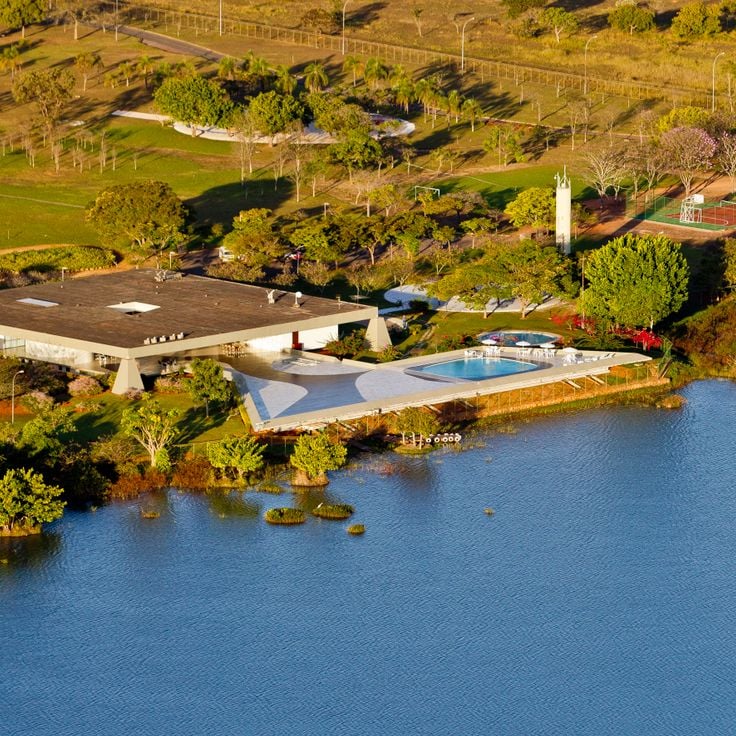
Brasília, Brazil
Palácio do JaburuThis 1973 palace serves as the official residence of Brazil's Vice President and represents a work by Oscar Niemeyer. The building displays the defining features of his architecture through its horizontal structure, extensive glass panels, and clear geometric lines. The palace contains four bedrooms, a reception hall, and administrative offices. The concrete and glass structure integrates into the planned cityscape of Brasília and complements Niemeyer's other modernist buildings in the capital.
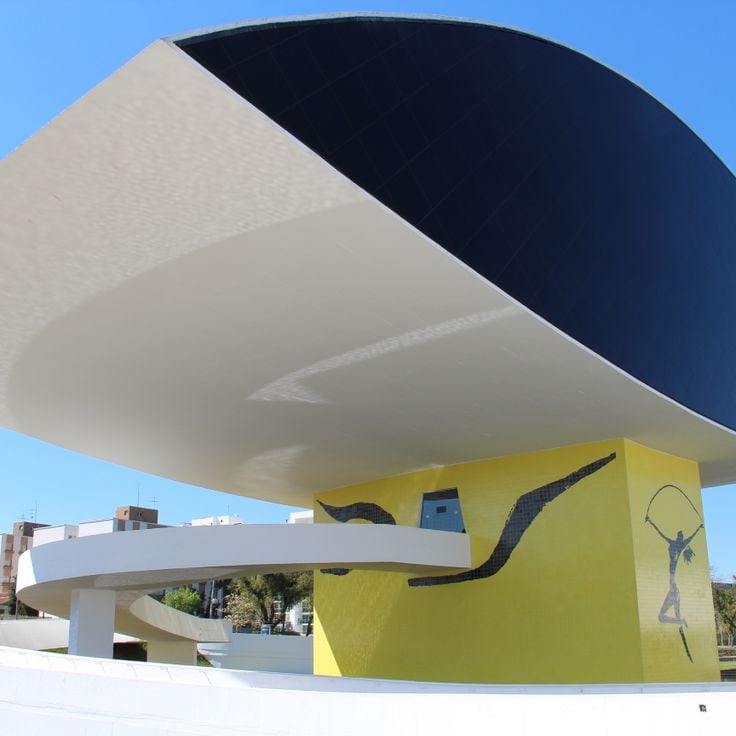
Paraná, Brazil
Oscar Niemeyer MuseumThe Museu Oscar Niemeyer presents Brazilian and international art collections within a building featuring curved lines and a distinctive red eye-shaped structure. This museum represents one of the architect's significant works and displays his preference for organic forms and monumental concrete construction. The red extension, suspended above a plaza, gives the complex its recognizable silhouette and demonstrates Niemeyer's ability to combine sculptural architecture with functional exhibition spaces.

Minas Gerais, Brazil
Church of Saint Francis of AssisiThis church in the Pampulha area represents one of Oscar Niemeyer's early works and displays his characteristic use of concrete and organic forms. Completed in 1943, the building was initially rejected by the Catholic Church but is now recognized as an important example of Brazilian modernism. The structure combines innovative architecture with religious function and demonstrates Niemeyer's ability to reinterpret traditional building forms. The church is part of the architectural complex at Pampulha Lake.
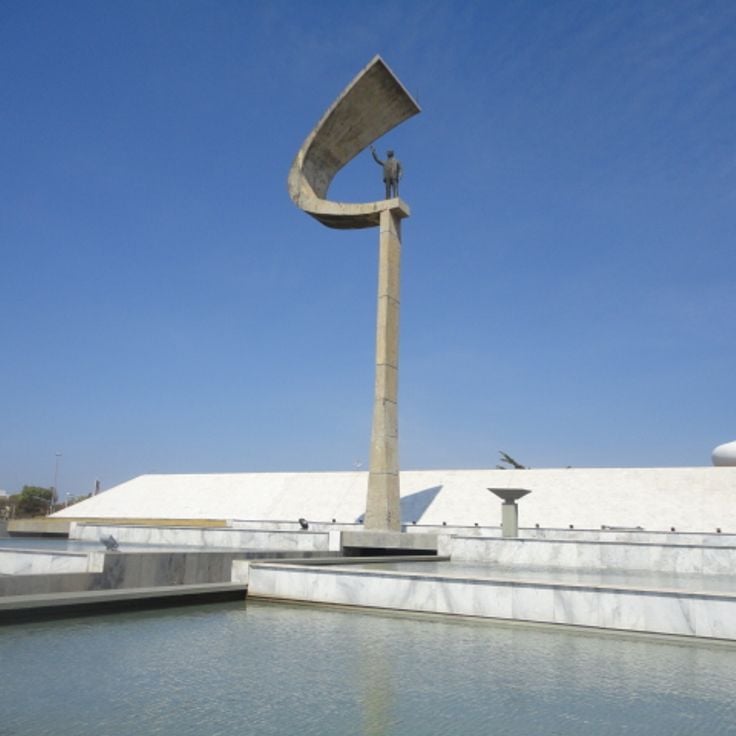
Federal District, Brazil
JK MemorialThe Mémorial JK is a 1981 building that houses the tomb of President Juscelino Kubitschek and an exhibition documenting the planning and construction of Brasília. This structure combines Niemeyer's characteristic concrete forms with geometric design and serves as a historical record of the Brazilian capital's creation. The exhibition presents the vision and realization of the modern city that emerged during Kubitschek's presidency.
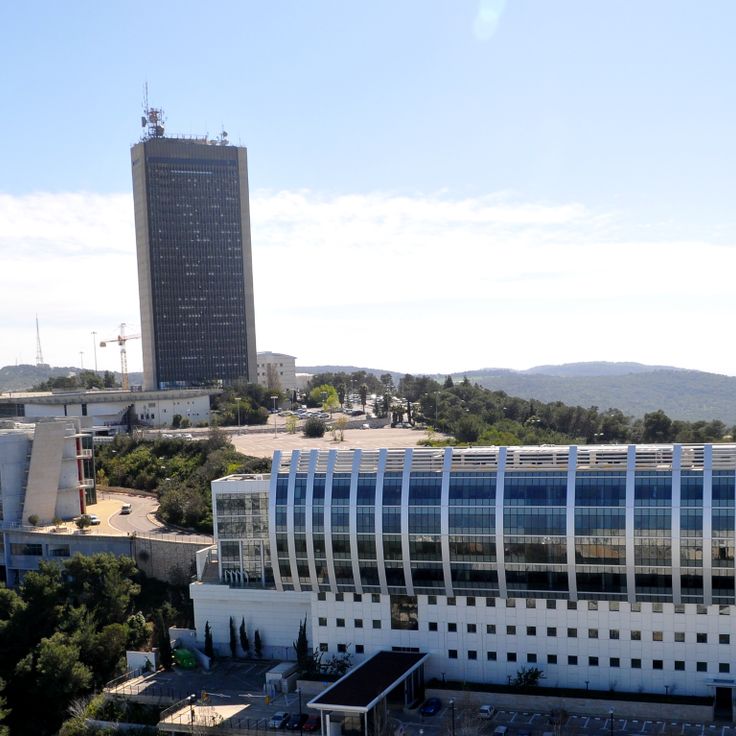
Haifa, Israel
University of HaifaThe 30-story Eshkol Tower was built in 1972 for the University of Haifa and houses university administrative offices, libraries, and research facilities. The building stands as part of Niemeyer's work, which defines Brazilian modernism through geometric forms and concrete structures extending from Brazil to Europe and the Middle East.
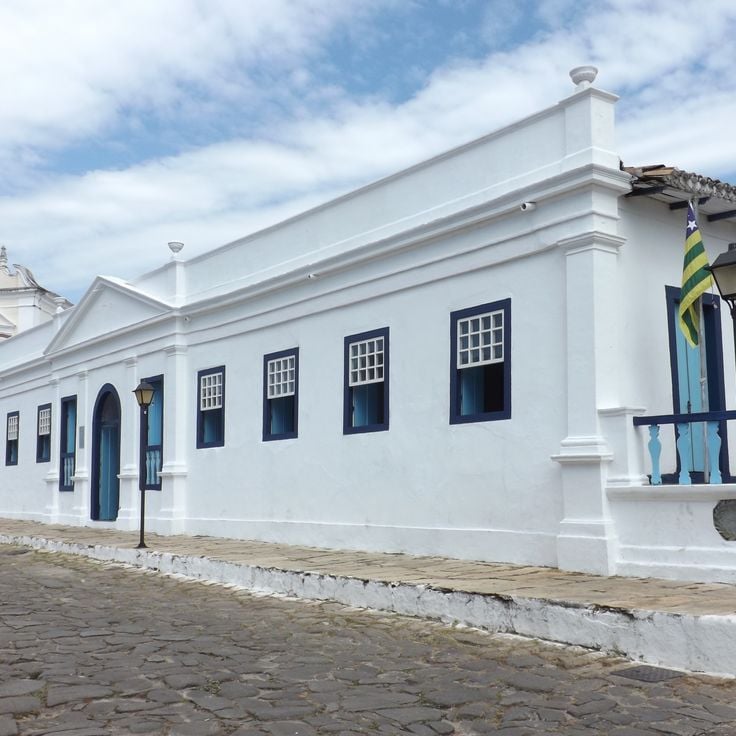
Federal District, Brazil
Palácio dos ArcosThe Palácio dos Arcos was completed in 1962 as part of Oscar Niemeyer's planning for Brasília and serves as the headquarters of the Ministry of Foreign Affairs. This building displays a white concrete facade with distinctive arches that run along the length of the structure and house diplomatic offices. The geometric arches form a rhythmic sequence and illustrate Niemeyer's approach to integrating form and function in the Brazilian capital. The complex sits on the Esplanada dos Ministérios and forms part of the architectural composition that defines the government district.
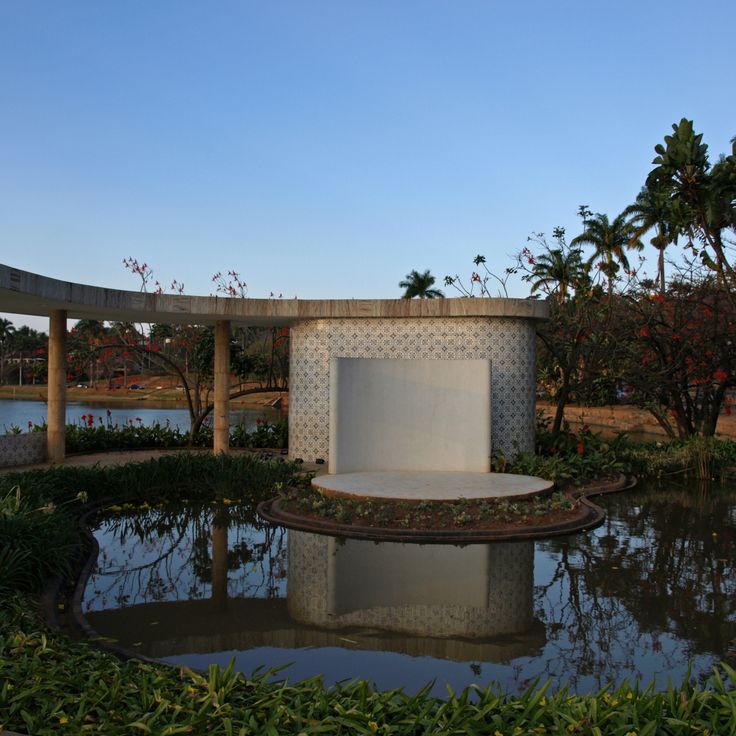
Minas Gerais, Brazil
Casa do BaileCasa do Baile stands on an artificial island in Lake Pampulha and was built in 1942 as Niemeyer's first work in this area. The building consists of a circular main hall and additional rooms connected by curved lines. The structure follows the organic forms of the shoreline and integrates water surfaces into the architecture. Originally designed as a dance hall and restaurant, the building demonstrates Niemeyer's interest in connecting architecture with landscape and in using geometric forms that characterize Brazilian modernism.

Rio de Janeiro, Brazil
Hotel NacionalThe Hotel Nacional is a 34-story building that opened in 1972 and displays Oscar Niemeyer's characteristic architectural features, including curved concrete forms and extensive glass surfaces. The high-rise embodies the Brazilian architect's modernist principles and fits into his body of work that encompasses geometric structures and bold concrete construction. The hotel's design reflects Niemeyer's approach to combining functional spaces with sculptural forms.
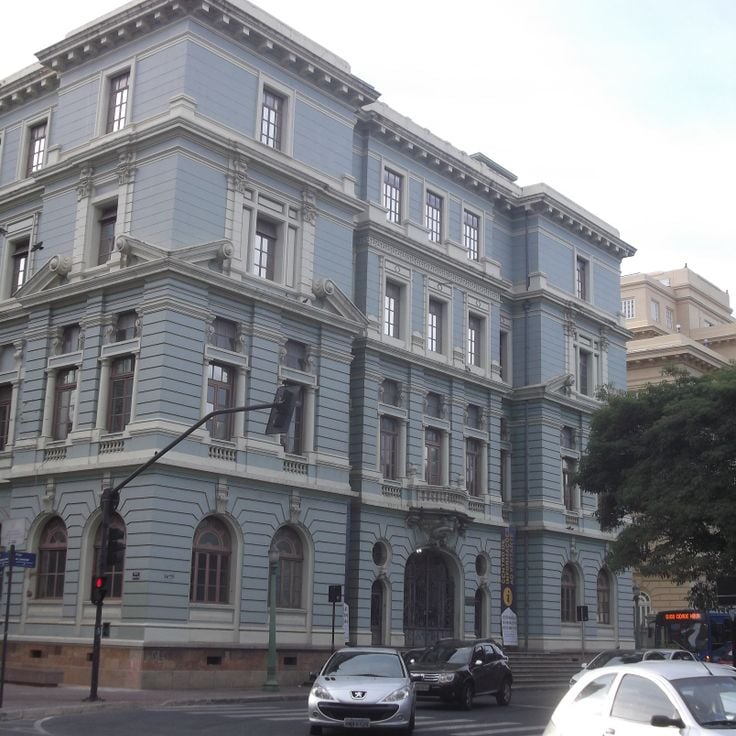
Minas Gerais, Brazil
Edifício Praça da LiberdadeThe Edifício Praça da Liberdade, an administrative building from 1960, demonstrates Oscar Niemeyer's approach to modernist architecture in Brazil through its S-shaped floor plan and distinctive vertical concrete fins on the facade. This building showcases the typical characteristics of Niemeyer's work with organic forms and expressive concrete construction. The vertical fins create a rhythmic pattern across the exterior while providing sun control for the interior spaces of the administrative complex.